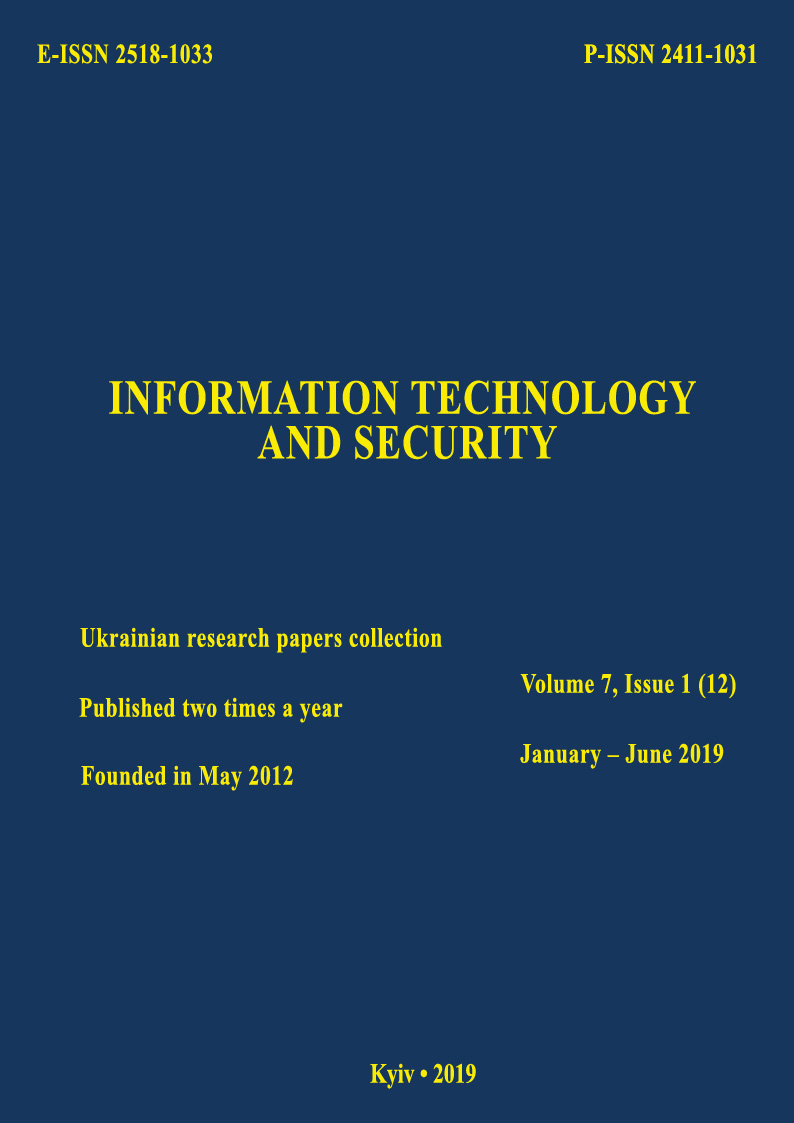System of automated data analysing about terroristic activity from Internet resources
DOI:
https://doi.org/10.20535/2411-1031.2019.7.1.184225Keywords:
Automated system, analysis of information, terrorist activity, softwareAbstract
A system for automated analysis of terrorist activity data from Internet resources was created. Its use is aimed at preventing and countering terrorist acts by analyzing textual content to contain data related to terrorist activity. This activity is one of the most severely predicted and dangerous for society and the state phenomena. It is characterized by a special dynamism and multifaceted nature, advanced technical equipment, a high level of structural organization, the presence of significant financial assets, as well as the ability to adapt and modernize in the context of the main social trends of today - globalization and informatization. This confirms the existence of a real threat to the national and cybersecurity of the state. Mostly to prevent and counter-terrorist activity, organizational measures are preferred. Therefore, counteraction to terrorist activity requires qualitatively new approaches. One such approach is to analyze terrorist activity data from Internet resources. To address this challenge, the widespread use of information technology, in particular software. In this context, automated data analysis tools are analyzed. Among them are specialized systems for monitoring information space. They are characterized, first of all, by the speed that traditional search engines cannot provide; secondly, the completeness not always provided by conventional news aggregators and, thirdly, the necessary analytical tools that allow the user to generate reports on publications of a given topic over some time. As a result, the use of automated data analysis is quite effective in preventing and counteracting terrorist attacks. Therefore, a system for automated analysis of terrorist activity data from Internet resources has been proposed for the implementation of such counteraction. The advantages of using it are the convenience, in particular, the presence of a simple interface and the ability to detect signs of terrorist activity
References
I. Bocharnikov, “Information Counteraction to Terrorism in Modern Conditions”. [Online]. Available: https://elibrary.ru/item.asp?id=21292041. Accessed: March 21, 2019.
B. Kemper, “Principles of Exploratory Data Analysis in Problem Solving: What Can We Learn from a Well-Known Case?”. [Online]. Available: https://www.researchgate.net/ publication/228410393_Principles_of_Exploratory_Data_Analysis_in_Problem_Solving_What_Can_We_Learn_from_a_Well-Known_Case. Accessed on: Mar 21, 2019. doi: 10.1080/08982110903188276 2009.
M. Ghada Tolan, and S. O. Soliman, “An Experimental Study of Classification Algorithms for Terrorism Prediction”, International Journal of Knowledge Engineering, vol. 1, no. 2, pp. 107-112, 2015. doi: 10.7763/IJKE.2015.V1.18.
“Data Mining Algorithms (Analysis Services – SQL Server 2014 Analysis Services”. [Online]. Available: https://docs.microsoft.com/en/sql/analysis-services/data-mining/data-mining-algorithms-analysis-services-data-mining?view=sql-server-2014. Accessed on: March 21, 2019.
V. Kumar, M. Mazzara, M. Gen., A. Messina, and J. Lee, “A Conjoint Application of Data Mining Techniques for Analysis of Global Terrorist Attacks – Prevention and Prediction for Combating Terrorism”, [Online]. Available: https://arxiv.org/abs/1901.06483. Accessed on: Mar 21, 2019. doi: 10.1007/978-3-030-14687-0_13.
Y. Elovici, A. Kandel, M. Last, B. Shapira, and O. Zaafrany, “Using Data Mining Techniques for Detecting Terror-Related Activities on the Web”. [Online]. Available: https://www.semanticscholar.org/paper/Using-Data-Mining-Techniques-for-Detecting-on-the-Elovici-Kandel/11d8bc502b639a1c31167502f2afacb3973695bc. Accessed on: March 21, 2019.
R. Okonkwo, and F. Enem, “Сombating crime and terrorism using data mining techniques”. [Online]. Available: https://www.semanticscholar.org/paper/Сombating-crime-and-terrorism-using-data-mining-Okonkwo-Enem/3dc2c4e99f0feae4f93fb2440a4eb5c1e40cf9cf. Accessed on: Mar 21, 2019.
Д. Ланде, та Н. Гулякіна, “Деякі нелінійні методи, що застосовуються при розпізнаванні інформаційних операцій”. [Електронний ресурс]. Доступно: http://dwl.kiev.ua/art/dffd/index.html. Дата звернення: Берез. 21, 2019.
A. Dudatyev, “Models to counter information attacks”, Ukrainian Information Security Research Journal, vol. 17, no. 2, pp. 1567-162, 2015. doi: 10.18372/2410-7840.17.8790.
“Electromagnetic wave equations in physics. SolverBook”. [Online]. Available: http://solverbook.com/spravochnik/uravneniya-po-fizike. Accessed on: March 21, 2019.
“The Sherman Kent Center for Intelligence Analysis”. [Online]. Available: http://www.au.af.mil/au/awc/awcgate/cia/strategic_warning_kent.htm. Accessed on: March 21, 2019.
Downloads
Published
How to Cite
Issue
Section
License
Copyright (c) 2020 Collection "Information technology and security"

This work is licensed under a Creative Commons Attribution 4.0 International License.
The authors that are published in this collection, agree to the following terms:
- The authors reserve the right to authorship of their work and pass the collection right of first publication this work is licensed under the Creative Commons Attribution License, which allows others to freely distribute the published work with the obligatory reference to the authors of the original work and the first publication of the work in this collection.
- The authors have the right to conclude an agreement on exclusive distribution of the work in the form in which it was published this anthology (for example, to place the work in a digital repository institution or to publish in the structure of the monograph), provided that references to the first publication of the work in this collection.
- Policy of the journal allows and encourages the placement of authors on the Internet (for example, in storage facilities or on personal web sites) the manuscript of the work, prior to the submission of the manuscript to the editor, and during its editorial processing, as it contributes to productive scientific discussion and positive effect on the efficiency and dynamics of citations of published work (see The Effect of Open Access).

